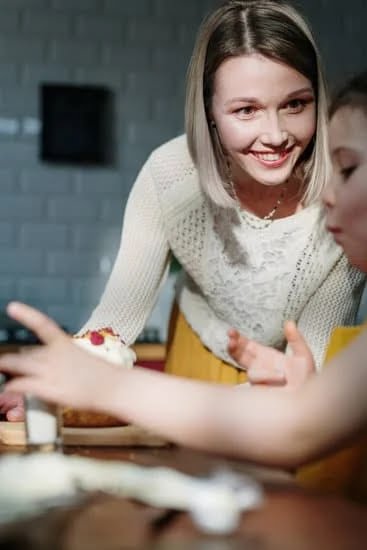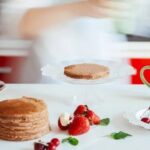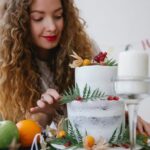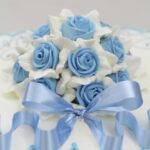Cake decorating is a delightful art form that allows individuals to express their creativity while bringing joy to others through delicious and visually appealing desserts. Whether it’s for a birthday, special occasion, or just a fun treat for family and friends, homemade cake decorating adds a special touch that store-bought cakes simply cannot match.
In this article, we will explore simple homemade cake decorating ideas that anyone can try, even if they have no prior experience in baking or decorating.
The art of cake decorating goes beyond just making a cake look pretty. It is about creating memories and celebrating milestones with loved ones. With the right tools and techniques, you can transform a plain cake into an edible masterpiece that will impress your guests and leave them asking for more. From beginner-friendly decorating techniques like buttercream piping to exploring the wonders of fondant, there are endless possibilities to explore in the world of cake decoration.
In addition to essential tools and ingredients for homemade cake decorating, we will also dive into the world of creative design ideas for various themes and occasions. You don’t need expensive equipment or fancy decorations to create stunning cakes – sometimes all you need are common household items and a bit of imagination. We’ll share some ingenious ways to unleash your creativity using everyday objects found in your home.
With our busy lives, finding time to decorate cakes may seem challenging. However, we have you covered with quick and easy cake decorating ideas that are perfect for busy individuals who want to add a personal touch to their creations without spending hours in the kitchen. In this article, we will also provide expert tips and troubleshooting solutions to address common challenges faced during homemade cake decoration.
So whether you’re new to baking or looking for fresh inspiration in your cake decorating journey, join us as we delve into the wonderful world of homemade cake decorating. Get ready to embrace your creativity and enjoy the rewards that come with creating beautiful and delicious treats from scratch.
Essential Tools and Ingredients for Simple Homemade Cake Decorating
One of the first steps in getting started with simple homemade cake decorating is gathering the essential tools and ingredients. Having the right equipment and supplies will make the process smoother and more enjoyable. Here are some key items to have on hand:
Baking Essentials
Before you can begin decorating your cakes, you’ll need to bake them first. Make sure you have a set of high-quality baking pans, such as round or square pans in various sizes. You’ll also need measuring cups and spoons, a mixing bowl, an electric mixer or whisk, and a rubber spatula for scraping down the sides of the bowl.
Icing and Frosting
No cake is complete without delicious icing or frosting. Basic buttercream frosting is a staple for simple cake decoration and can be made using butter, powdered sugar, vanilla extract, and milk or cream. Alternatively, you can purchase ready-made icing from the store if you’re short on time.
For more advanced decorations and designs, consider working with fondant. Fondant is a smooth icing-like substance that can be rolled out and draped over cakes for a flawless finish. It can be purchased pre-made or made from scratch using gelatin, water, glucose syrup, glycerin, and powdered sugar.
Decorating Tools
To bring your cake to life with beautiful designs, you’ll need a few specialty tools. A cake turntable is a must-have for easy access to all sides of your cake while decorating. Piping bags with different tips will allow you to create various shapes and patterns with your icing. Offset spatulas are great for applying icing smoothly onto your cakes.
Other helpful tools include a bench scraper or palette knife for smoothing icing surfaces, an angled spatula for precise edges and corners, and an assortment of fondant molds or cutters for creating detailed shapes or accents.
By having these essential tools and ingredients in your cake decorating arsenal, you’ll be well-equipped to take on simple homemade cake decoration projects with ease and confidence. Remember to practice and experiment with different techniques to develop your own unique style.
Beginner-Friendly Decorating Techniques
Decorating a cake can seem like a daunting task, especially for beginners. But fear not, because there are several beginner-friendly decorating techniques that you can try with ease. In this section, we will explore two popular options: buttercream and fondant.
Buttercream
Buttercream is a versatile and forgiving frosting that is ideal for beginners. It is made by combining butter, powdered sugar, vanilla extract, and a liquid such as milk or heavy cream. To achieve the desired consistency for decorating, you can add more liquid or powdered sugar as needed.
One simple yet effective way to decorate with buttercream is by using a piping bag and different tips. Start by filling the piping bag with the desired color of buttercream icing and twist the top to create pressure. Hold the bag at a 45-degree angle and gently squeeze to pipe your desired design onto the cake. You can experiment with different tips to create various shapes such as stars, rosettes, shells, or even writing.
Another technique is known as the “spatula technique.” After applying a crumb coat to your cake (a thin layer of frosting to seal in any crumbs), use an offset spatula to spread an even layer of buttercream on the sides and top of the cake. For a smooth finish, hold the spatula parallel to the cake surface and rotate it while maintaining constant pressure against the frosting.
Fondant
Fondant is another popular choice when it comes to cake decorating. It is a pliable icing made from marshmallows or gelatin mixed with confectioners’ sugar. Fondant allows you to create smooth finishes and intricate designs on your cakes.
To work with fondant, start by kneading it until it becomes soft and pliable. Dust your work surface with confectioners’ sugar or cornstarch to prevent sticking. Roll out the fondant to the desired thickness and carefully drape it over your cake. Smooth out any air bubbles or wrinkles using gentle strokes with your hands.
Once the fondant is in place, you can add additional decorations such as cut-out shapes, flowers, or ribbons made from fondant. For these smaller designs, you can use food coloring to achieve different colors and simply shape them by hand or with the help of molds.
Remember that both buttercream and fondant take practice, so don’t be disheartened if your first attempts are not perfect. The more you practice, the better you will become at mastering these beginner-friendly decorating techniques. And remember, the most important thing is to have fun and enjoy the process of creating a beautifully decorated homemade cake.
Decorating with Common Household Items
When it comes to cake decorating, you don’t always need expensive tools or specialized equipment. In fact, some of the most stunning decorations can be achieved using common household items. These everyday objects can unleash your creativity and add a unique touch to your homemade cakes.
One versatile household item that can be used for cake decorating is a toothpick. Toothpicks can help you create intricate designs or patterns on the surface of your cake. You can use them to draw delicate lines, swirls, or even write messages on the cake.
Another household item that can be repurposed for cake decorating is a plastic sandwich bag. Fill the bag with frosting or icing, push all the frosting towards one corner of the bag, and then snip a small hole off that corner. This makeshift piping bag can be used to pipe designs onto your cakes with precision and control.
Additionally, cookie cutters are not just for making cookies. They can also serve as stencils for creating beautiful shapes and patterns on your cakes. Place the cookie cutter on top of the cake and use it as a guide to sprinkle powdered sugar or cocoa powder in desired shapes.
You may also find that unconventional items such as straws, spoons, or even bottle caps can create interesting textures on frosted cakes. Experimentation is key when working with household items for cake decorating – don’t be afraid to try out different objects and see what effects they produce.
By utilizing these common household items in your cake decorating endeavors, you not only save money but also tap into your imagination and resourcefulness. Letting go of traditional tools and thinking outside the box allows you to unleash your creativity and achieve unique designs that truly reflect your personal style. So next time you’re in need of cake decorations, take a look around your home – you might be surprised at what you find.
Quick and Easy Cake Decorating Ideas for Busy Individuals
When it comes to cake decorating, there are plenty of quick and easy ideas that can help busy individuals create stunning cakes without spending hours in the kitchen. Whether you are a beginner or an experienced baker, these simple techniques will allow you to add a touch of creativity to your homemade cakes in no time.
One quick and easy cake decorating idea is to use edible flowers as a decorative element. You can easily find edible flowers at your local grocery store or online. Simply place the flowers on top of your frosted cake or scatter them around the sides for a beautiful and natural look. Edible flowers not only add visual appeal but also provide a unique flavor profile to your cake.
Another time-saving technique is using stencils to create intricate designs with powdered sugar or cocoa powder. This method requires minimal effort yet achieves impressive results. Place the stencil on top of your cake, sprinkle powdered sugar or cocoa powder over it, and carefully remove the stencil to reveal a stunning pattern. This technique works especially well on single-layer cakes or cupcakes.
If you’re short on time but still want to add some pizzazz to your cake, consider using colorful sprinkles or edible glitter. These simple additions can instantly transform a plain cake into something eye-catching and festive. Sprinkle them over the frosting for a sparkling effect or create patterns with different colors for a fun and playful design.
Creative Design Ideas for Various Themes and Occasions
When it comes to cake decorating, one of the most exciting aspects is choosing a theme or occasion to base your design on. Whether you’re celebrating a birthday, anniversary, holiday, or just want to bring some joy to a gathering, incorporating a specific theme into your cake design can make it even more memorable. Here are some creative design ideas for various themes and occasions to inspire your homemade cake decorating endeavors:
- Birthday Cakes: Birthdays are the perfect time to let your creativity shine. Consider incorporating the birthday person’s favorite colors, hobbies, or interests into the design. For example, if they love sports, create a cake that resembles their favorite ball or stadium. Alternatively, you can personalize the cake with their name or age using piping techniques.
- Wedding Cakes: Weddings are often associated with elegance and romance. For a classic look, opt for a tiered cake adorned with delicate sugar flowers or intricate lace designs made from fondant. If you want to add a modern twist, consider incorporating metallic accents or geometric patterns.
- Holiday Cakes: Holidays provide endless opportunities for themed cake designs. For Halloween, you can create a spooky graveyard scene complete with tombstones and ghosts made from icing. On Christmas, decorate your cake with edible snowflakes and sprinkle powdered sugar on top for a snowy effect.
- Baby Shower Cakes: Welcoming a new addition is an exciting occasion that calls for adorable designs such as baby booties or rattles made out of fondant or marzipan. You can also incorporate pastel colors and cute animal figures to complement the joyful atmosphere.
Remember that these ideas are just starting points – feel free to combine different elements and get creative. With homemade cake decorating, there are no limits to what you can achieve when it comes to bringing joy and creating memories through beautiful edible art.
Expert Tips for Perfecting Your Homemade Cake Decorations
Decorating a homemade cake can be both exciting and challenging, but with the right techniques and expert tips, you can create stunning designs that will wow your friends and family. Here are some expert tips to help you perfect your homemade cake decorations.
Firstly, it’s important to make sure that your cake is completely cooled before you start decorating. If your cake is still warm, the icing or frosting may melt and ruin your design. To cool your cake quickly, you can place it in the refrigerator for about 30 minutes.
Another tip is to always crumb coat your cake before applying the final layer of icing or frosting. Crumb coating involves applying a thin layer of icing to seal in any loose crumbs on the surface of the cake. This will help give you a smoother finish when you apply the final layer of icing.
When working with buttercream, it’s essential to keep your piping bag filled with just enough icing to avoid squeezing too hard or running out before completing your design. Overfilling the piping bag can cause uneven pressure and result in messy decorations. It’s also helpful to practice different pressure techniques on a piece of parchment paper before applying them directly onto your cake.
If you’re using fondant for decoration, knead it well before rolling it out to ensure that it’s smooth and pliable. Dusting your work surface with powdered sugar or cornstarch can prevent the fondant from sticking as you roll it. Additionally, using a silicone rolling pin instead of a wooden one can make it easier to achieve an even thickness.
Lastly, remember that practice makes perfect when it comes to cake decorating. Don’t be afraid to experiment with different techniques and designs. Keep practicing and trying new things, and soon you’ll be creating professional-looking homemade cakes that will impress everyone.
By following these expert tips, you’ll be on your way to perfecting your homemade cake decorations. Remember to have fun and enjoy the process, as homemade cake decorating allows you to unleash your creativity and create delicious works of art.
Troubleshooting
Cake decorating can be a fun and rewarding activity, but it is not without its challenges. In this section, we will explore some common challenges that arise during cake decorating and provide solutions to overcome them.
One common challenge in cake decorating is achieving a smooth and even frosting on the cake. Sometimes, air bubbles or crumbs may appear in the frosting, causing an uneven finish.
To solve this problem, it is important to start with a crumb coat – a thin layer of frosting that helps seal any crumbs and create a smooth base for the final coat of frosting. After applying the crumb coat, refrigerate the cake for about 15 minutes to allow it to set before adding the final layer of frosting.
Another issue that decorators often face is piping consistency. It can be frustrating when your buttercream or royal icing does not hold its shape or comes out too runny or stiff.
To achieve the right consistency for piping, it is essential to have your ingredients at room temperature and follow precise measurements when making your icing. If your icing is too runny, add more powdered sugar; if it’s too stiff, add small amounts of liquid (such as milk or water) until you reach the desired consistency.
Additionally, creating vibrant colors with food coloring can be challenging at times. Sometimes, certain colors may turn out dull or faded on the cake. To intensify colors, use gel-based food coloring instead of liquid food coloring as they are more concentrated. Start with a small amount of color and gradually add more until you get the desired result. Remember that some colors may deepen over time, so allow them to sit for a while before adjusting further.
| Common Challenge | Solution |
|---|---|
| Air bubbles in frosting | Apply a crumb coat and refrigerate before final frosting. |
| Inconsistent piping consistency | Ensure ingredients are at room temperature and follow precise measurements. |
| Dull or faded colors | Use gel-based food coloring and allow them to sit for a while to intensify. |
By addressing these common challenges in cake decorating, you can achieve professional-looking cakes that are visually appealing and taste delicious. Don’t be discouraged by setbacks along the way, as troubleshooting is an essential part of the learning process. With practice and perseverance, you will become more confident and skilled in creating beautiful homemade cake decorations.
Inspiring Examples
As the saying goes, “a picture is worth a thousand words,” and when it comes to cake decorating, seeing inspiring examples can be incredibly helpful. In this section, we will showcase some simple homemade cake decorating ideas that are sure to ignite your creativity and give you the confidence to try them yourself. Whether you’re a beginner or an experienced baker looking for new ideas, these examples will provide you with great inspiration.
One popular decorating idea that never fails to impress is the use of fresh flowers on cakes. This simple yet elegant technique adds a touch of nature to your creations and can instantly elevate any cake design. Some popular choices for flowers include roses, orchids, and lavender. It’s important to note that when using fresh flowers, they should be pesticide-free and thoroughly cleaned before using them on edible surfaces.
Another great way to create stunning effects is by using different piping techniques. Piping allows you to add intricate details and designs to your cakes with just a simple pastry bag and various tips. For example, you can create beautiful rosettes by starting in the center of the cake and slowly swirling around until you reach the desired size. You can also make delicate lace-like patterns or write personalized messages using different types of piping tips.
Using edible decorations is another fantastic way to enhance your homemade cakes. From colorful sprinkles and edible glitter to chocolate shavings and fruit slices, there are endless possibilities for adding extra flair to your creations. For instance, sprinkling some gold or silver dust on top of a plain white cake instantly transforms it into an elegant masterpiece fit for special occasions.
| Decorating Idea | Data |
|---|---|
| Flowers as decorations | Popular choices: roses, orchids, lavender |
| Piping techniques | Examples: rosettes, lace patterns, personalized messages |
| Edible decorations | Examples: sprinkles, edible glitter, chocolate shavings, fruit slices |
Conclusion
In conclusion, homemade cake decorating is an enjoyable and rewarding activity that allows you to unleash your creativity and create beautiful desserts for any occasion. With the essential tools and ingredients, as well as beginner-friendly techniques like buttercream and fondant, anyone can start decorating cakes with ease. Additionally, decorating with common household items opens up a world of possibilities for unique and personalized designs.
To make cake decorating more accessible for busy individuals, there are quick and easy ideas that can be effortlessly executed in a short amount of time. Whether it’s a last-minute celebration or a surprise treat for loved ones, these ideas ensure that you can still create impressive cakes without sacrificing too much time or effort.
For those looking to take their skills to the next level, there are various creative design ideas for different themes and occasions. From birthdays to weddings to holidays, there is no limit to the creativity that can be expressed through cake decoration. Expert tips can also help perfect your homemade creations by providing guidance on techniques such as piping, coloring, and layering.
Although cake decorating may come with its share of challenges, troubleshooting common issues such as uneven frosting or cracked fondant can help overcome these obstacles. With practice and patience, you can overcome these challenges and achieve professional-looking results.
Finally, the article showcases inspiring examples of simple homemade cake decorations. These examples serve as proof that anyone can create stunning cakes at home with just a little bit of creativity and effort.
By embracing your creative side and enjoying the rewards of homemade cake decorating, you will not only impress your friends and family but also experience the joy of creating something beautiful from scratch. So go ahead, grab your tools and ingredients, let your imagination run wild, and start creating delicious works of art.
Frequently Asked Questions
What is the easiest cake to decorate?
The easiest cake to decorate is often a simple round or rectangular cake with a flat surface. These types of cakes provide a clean canvas for decorating, making it easier to work with. Additionally, cakes that have been cooled and refrigerated prior to decoration tend to be more stable, allowing for smoother and more precise designs.
Beginners can start by using buttercream frosting to create basic designs such as swirls or dots. This type of frosting is forgiving and easy to work with, making it ideal for those new to cake decorating.
How to decorate simple homemade cake?
Decorating a simple homemade cake can be done in various ways to achieve an aesthetically pleasing result. First, it’s important to ensure that the baked cake has cooled completely before starting the decoration process. Next, you can choose a frosting technique depending on your preference – whether it’s smooth and sleek or textured and rustic.
Using different piping tips or spatulas, you can experiment with creating patterns or ruffles on the cake’s surface. Adding colored sprinkles or edible decorations like flowers can also enhance the overall look of the cake without requiring advanced techniques.
How to decorate a cake without anything?
Decorating a cake without anything may seem challenging at first, but there are creative ways to make a visually appealing dessert without traditional decorations. One option is focusing solely on the texture of the cake itself by using interesting batters or layering different flavors together.
This could involve marbling chocolate and vanilla batter or adding crunchy elements like nuts or caramelized sugar on top of the baked cake for contrast in both flavor and appearance. Additionally, dusting powdered sugar over the entire surface can provide an elegant simplicity while highlighting any intricate details in the shape of the cake itself.

Welcome to our cake decorating blog! My name is Destiny Flores, and I am the proud owner of a cake decorating business named Cake Karma. Our mission is to provide delicious, beautiful cakes for all occasions. We specialize in creating custom cakes that are tailored specifically to each customer’s individual needs and tastes.





